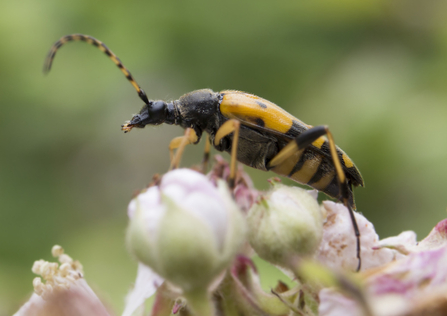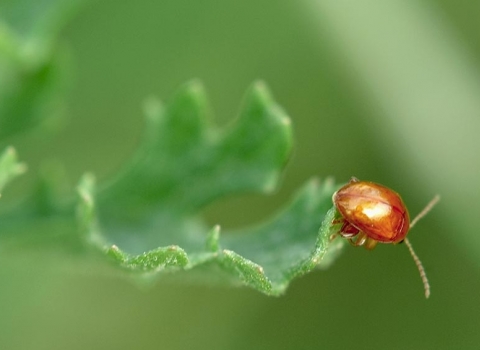Beetles are insects in the order Coleptera, meaning ‘sheath-winged’. In ‘classic’ beetles, their front wings are modified into protective shields that cover the back, keeping the more fragile flying wings safe when folded away.
Like the butterfly, the beetle goes through a complete ‘metamorphosis’ to reach maturity. First, the adult lays an egg, which hatches into a larva (or grub). Then the grub eats to grow, shedding its skin several times before turning into a pupa. Finally, this pupa hatches into the adult beetle.
When beetles first hatch, their hard wing-covers are soft, making the beetle vulnerable. It takes time for them to dry and harden. Once a beetle has hatched it does not grow further, so there is no such thing as a ‘baby’ beetle – just big and small species.
Benefits of beetles
With 4,000 known species in the UK, beetles play vital roles within a healthy functioning ecosystem.
Adult beetles such as the black and yellow longhorn and common red soldier-beetle are important pollinators. Ladybirds are the gardener’s greatest ally as enthusiastic predators of greenfly, while ground beetles eat many other invertebrates that are pests to our crops. Meanwhile our native glow-worm (not actually a worm but a beetle!) specialises in eating snails.
Beetles also recycle dung, dead wood and carrion. Dor beetles go further, burying animal dung and laying their eggs on it. This helps get nutrients into the soil, getting rid of cow pats at the same time! In Australia, it was discovered that native dung beetles were ignoring the dung of imported cattle, so dung beetles from other countries were brought to the rescue. Now the foreign beetles help process over 30 million tonnes of cow-pats every year.
Beetles also form a major food source for many birds and mammals. Wading birds and starlings probe fields for cockchafer grubs living in the soil, whilst noctule bats get an important boost when the nocturnal adult beetles emerge in May. Beetles are also a favourite food of hedgehogs.



